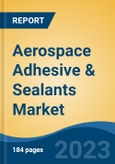Speak directly to the analyst to clarify any post sales queries you may have.
10% Free customizationThis report comes with 10% free customization, enabling you to add data that meets your specific business needs.
The demand for these materials has surged with rising aircraft production, the growing use of composite structures, and an increased focus on aircraft maintenance, repair, and overhaul (MRO) activities. As aerospace manufacturers prioritize lightweight construction to improve fuel efficiency and reduce emissions, specialized adhesives and sealants designed for bonding composites are in high demand. Additionally, the push for sustainability is fostering interest in low-VOC, environmentally friendly formulations. The expanding aircraft fleet and the growing MRO sector globally continue to create robust growth opportunities for adhesive and sealant manufacturers catering to the aerospace market.
Key Market Drivers
Expansion of the global aerospace industry
The rapid expansion of the global aerospace industry is a major catalyst for the growth of the aerospace adhesive & sealants market. As air travel demand surges and commercial and defense aircraft fleets grow, the need for reliable bonding and sealing materials increases in tandem. Adhesives and sealants are essential for ensuring structural performance, reducing weight, and maintaining safety standards in both new aircraft assembly and ongoing maintenance tasks.Manufacturers like Boeing and Airbus have scaled up production to meet global demand, reinforcing the market for adhesive and sealant applications in fuselage assembly, wing structures, and interior components. Additionally, technological advancements - such as AI-driven predictive maintenance and real-time performance monitoring - are further elevating production complexity, thereby increasing the need for high-performance bonding solutions. These developments are propelling demand for innovative adhesives and sealants that meet modern aerospace standards.
Key Market Challenges
Economic downturns
The aerospace adhesive & sealants market is highly susceptible to the impacts of global economic downturns. During periods of reduced economic activity, airlines often delay or scale back fleet expansions and maintenance schedules, directly reducing the demand for bonding and sealing materials. Budget constraints may also limit research and development efforts, slowing innovation in adhesive technologies.Similarly, in the defense sector, economic pressures can result in reduced government expenditure on military aviation, impacting procurement and maintenance activities. These cyclical economic patterns pose ongoing challenges for market participants, requiring adaptive strategies and cost optimization measures to maintain resilience and competitiveness.
Key Market Trends
Growing popularity of unmanned aerial vehicles (UAVs)
The rising use of unmanned aerial vehicles (UAVs) across commercial, defense, and industrial applications is shaping the future of the aerospace adhesive & sealants market. UAVs rely heavily on lightweight construction, and adhesives play a pivotal role in assembling airframes, sensors, and propulsion systems without adding unnecessary weight.As drone deployment accelerates in sectors such as logistics, agriculture, and surveillance, the demand for adhesives and sealants tailored to UAV requirements is increasing. These materials ensure structural durability and environmental resistance while supporting the miniaturization and agility demanded by UAV designs. This trend is driving innovation in low-weight, high-performance formulations, opening new avenues for growth within the aerospace adhesives and sealants landscape.
Key Market Players
- 3M
- Bostik SA
- Cytec-Solvay
- Dow, Inc.
- DuPont de Nemours, Inc.
- H.B. Fuller
- Henkel AG
- Hexcel Corporation
- Huntsman Corporation
- Illinois Tool Works Inc.
- Lord Corporation
- Master Bond
- PPG Industries
Report Scope:
In this report, the Global Aerospace Adhesive & Sealants Market has been segmented into the following categories, in addition to the industry trends which have also been detailed below:Aerospace Adhesive & Sealants Market, By Resin Type:
- Epoxy
- Polyurethane
- Other
Aerospace Adhesive & Sealants Market, By Technology:
- Solvent-Based
- Water-Based
- Other
Aerospace Adhesive & Sealants Market, By End User:
- Commercial
- Military
- Other
Aerospace Adhesive & Sealants Market, By Region:
- Asia-Pacific
- China
- India
- Japan
- Australia
- South Korea
- North America
- United States
- Canada
- Mexico
- Europe
- France
- United Kingdom
- Italy
- Germany
- Spain
- South America
- Brazil
- Argentina
- Colombia
- Middle East & Africa
- South Africa
- Saudi Arabia
- UAE
Competitive Landscape
Company Profiles: Detailed analysis of the major companies present in the Global Aerospace Adhesive & Sealants Market.Available Customizations:
With the given market data, the publisher offers customizations according to a company's specific needs. The following customization options are available for the report.Company Information
- Detailed analysis and profiling of additional market players (up to five).
This product will be delivered within 1-3 business days.
Table of Contents
Companies Mentioned
- 3M CO
- Bostic SA
- Cytec-Solvay
- Dow, Inc.
- DuPont de Nemours, Inc.
- H.B. Fuller
- Henkel AG
- Hexcel Corporation
- Huntsman Corporation
- Illinois Tool Works Inc.
- Lord Corporation
- Master Bond
- PPG Industries
Table Information
| Report Attribute | Details |
|---|---|
| No. of Pages | 185 |
| Published | July 2025 |
| Forecast Period | 2024 - 2030 |
| Estimated Market Value ( USD | $ 1.06 Billion |
| Forecasted Market Value ( USD | $ 1.45 Billion |
| Compound Annual Growth Rate | 5.3% |
| Regions Covered | Global |
| No. of Companies Mentioned | 13 |









